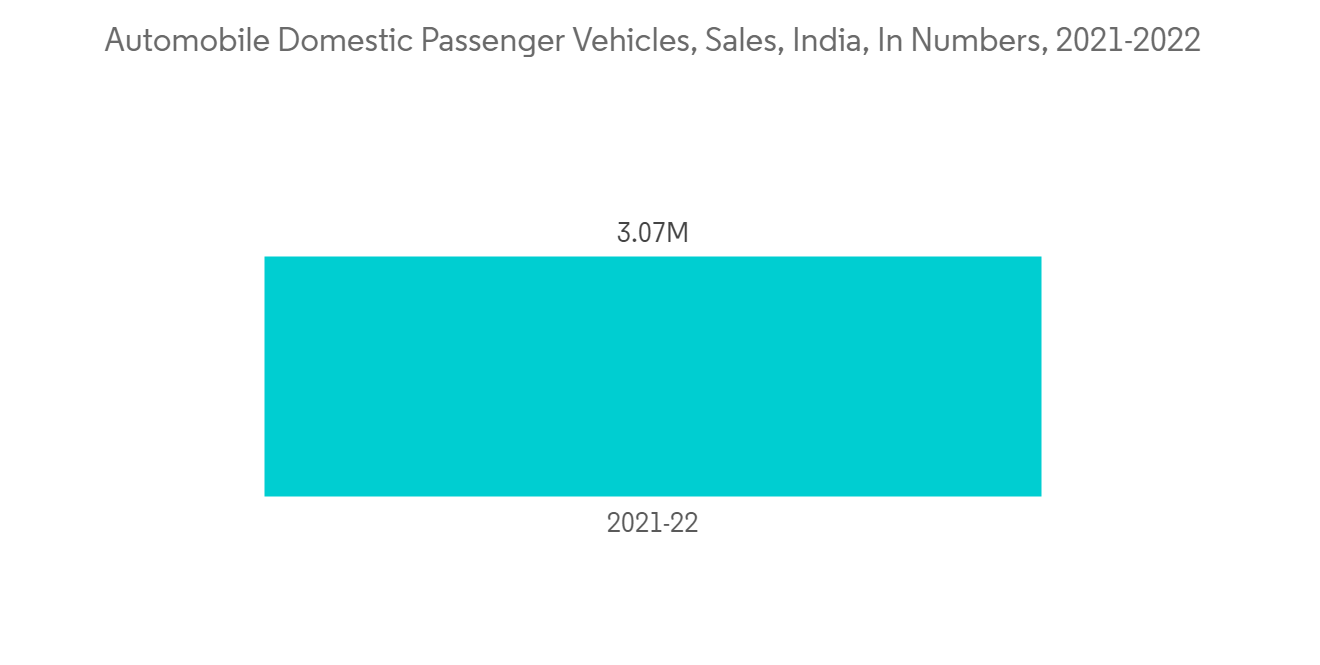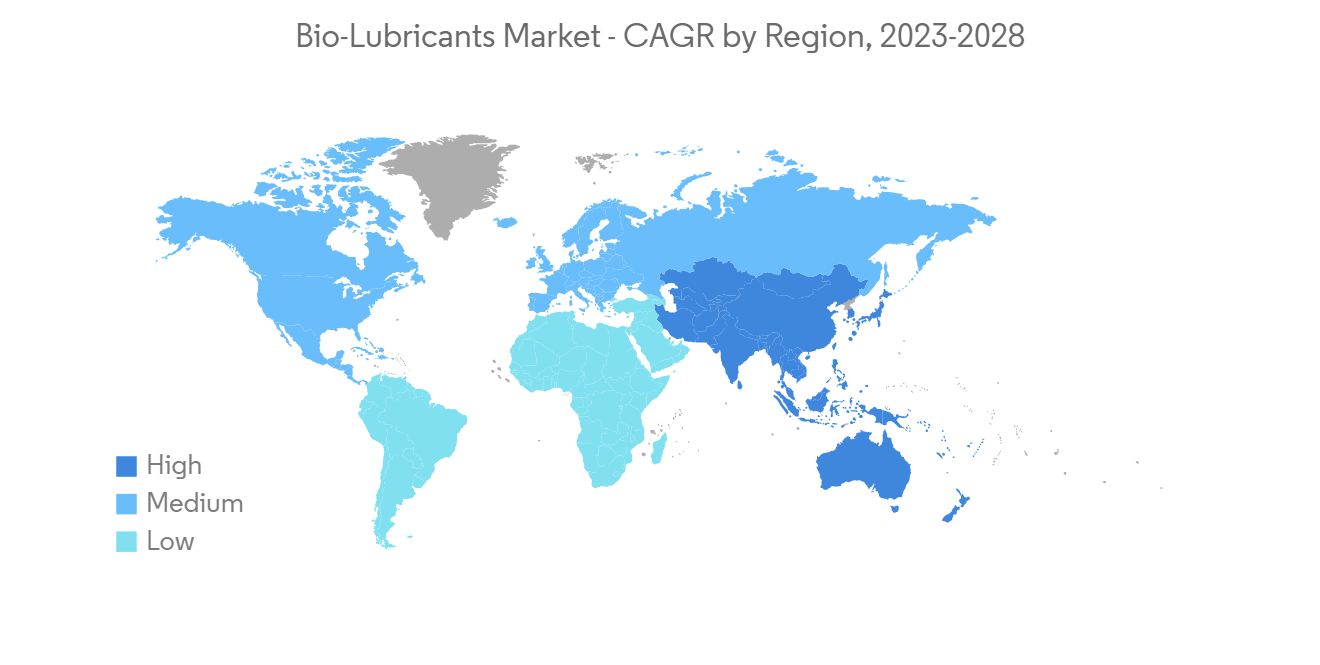 |
市场调查报告书
商品编码
1272699
生物润滑油市场——增长、趋势和预测 (2023-2028)Bio-Lubricants Market - Growth, Trends, and Forecasts (2023 - 2028) |
||||||
价格
※ 本网页内容可能与最新版本有所差异。详细情况请与我们联繫。
简介目录
在预测期内,生物润滑油市场预计将以超过 3% 的复合年增长率增长。
主要亮点
- COVID-19 对 2020 年的市场产生了负面影响。 不过,预计市场将在2022年达到疫情前的水平,并继续保持稳定增长。
- 生物基润滑剂不会引起通常由石油基润滑剂引起的皮肤刺激。 此外,还有各种优势,如减少能源使用和劳动力成本、提高员工安全、改善环境条件、延长机器寿命和增加产量,这些都在推动市场的增长。
- 生物润滑剂是通过脂肪酸的酯化或植物油的酯交换产生的。 该步骤是在均相酸/碱催化剂 8-10 存在下或使用离子交换树脂用长链醇进行的。 这个过程增加了生物基润滑剂的成本。 这被认为会阻碍市场增长。
- 已完成各种研究和开发项目,以提高生物基润滑油的物理化学性能。 这些研究发现,生物基润滑油可以作为石油基油品的替代品,有望成为市场机遇。
- 亚太地区主导着全球市场,中国、印度和日本等国家/地区的消费量最大。
生物润滑油市场趋势
汽车和运输领域对生物润滑油的需求不断扩大
- 汽车和运输行业在生物润滑油市场占有很大份额。 运输行业专注于提高润滑油性能,例如性能、寿命、能源效率和环境友好性。 Biogrease 适用于各种应用,包括建筑车辆、林业设备、铁路法兰、铁路曲线和导航设备。
- 许多行业都在使用生物基金属切削液和冷却剂进行磨削、齿轮切削和通用机械加工,这有望推动市场增长。 生物基润滑油具有毒性低、粘度指数高、润滑性能强、机器寿命长、燃烧温度高等特点,有望在汽车行业中逐步超越传统润滑油。
- 中国汽车工业的扩张预计会打开对生物润滑油的需求。 根据国际汽车製造商协会 (OICA) 的数据,中国是最大的汽车生产国。 2021 年仅中国就将生产 26,082,220 辆汽车。
- 在印度,乘用车和商用车的销量大幅增长。 例如,2021-2022年国内乘用车销量为3,069,499辆,较2020-21年增长13%。 预计所有上述因素都将在预测期内推动全球市场。

亚太地区主导市场
- 中国是亚太地区第三大生物润滑油消费国。 该地区发电行业的扩张预计将在预测期内推动生物润滑油市场。
- 2021 年,印度的可再生能源装机容量超过 147.1 吉瓦。 这超过了 2020 年研究期间 134.5 GW 的峰值,极大地支持了市场的增长。
- 2021 年中国的发电量约为 8377 太瓦时。 这比上一年增长了近10%。 2021年除水电外的所有能源消耗量都将增加,风能和太阳能的使用量将增加。
- 此外,日本政府还计划在国内新建 45 座采用优质黑煤的高能低排放技术的燃煤电厂。 随着该国发电厂数量的增加,预计在预测期内对发电厂使用的生物润滑油的需求将加速增长。
- 因此,预计电力行业的这种增长将推动亚太地区的生物润滑油市场。

生物润滑油行业概况
生物润滑油市场因其性质而分散。 市场主要参与者包括 BP p.l.c.、雪佛龙公司、埃克森美孚公司、TotalEnergies、FUCHS 等。
其他福利:
- Excel 格式的市场预测 (ME) 表
- 3 个月的分析师支持
内容
第一章介绍
- 调查结果
- 本次调查的假设
- 本次调查的范围
第二章研究方法论
第 3 章执行摘要
第四章市场动态
- 主持人
- 监管规范推动了对生物基润滑油的需求
- 其他司机
- 约束因素
- 生物基润滑油价格高
- 其他抑製剂
- 工业价值链分析
- 波特的五力分析
- 供应商的议价能力
- 消费者的议价能力
- 新进入者的威胁
- 替代品的威胁
- 竞争程度
第 5 章市场细分(市场规模:基于金额)
- 产品类型
- 机油
- 变速箱/液压油
- 金属加工油
- 一般工业用油
- 齿轮油
- 润滑脂
- 工艺油
- 其他产品类型
- 最终用户行业
- 发电厂
- 汽车和其他运输设备
- 重型机械
- 食物和饮料
- 冶金和金属加工
- 化学工业
- 其他最终用户行业
- 地区
- 亚太地区
- 中国
- 印度
- 日本
- 韩国
- 其他亚太地区
- 北美
- 美国
- 加拿大
- 墨西哥
- 其他北美地区
- 欧洲
- 德国
- 英国
- 意大利
- 法国
- 俄罗斯
- 其他欧洲
- 南美洲
- 巴西
- 阿根廷
- 其他南美洲
- 中东和非洲
- 沙特阿拉伯
- 南非
- 阿拉伯联合酋长国
- 其他中东和非洲地区
- 亚太地区
第六章竞争格局
- 併购、合资、合作、合同等。
- 市场份额 (%)**/排名分析
- 各大公司的招聘策略
- 公司简介
- Axel Christiernsson
- Carl Bechem Lubricants India Private Limited
- BP p.l.c.
- Cargill
- Chevron Corporation
- Cortec Corporation
- Environmental Lubricants Manufacturing, Inc.
- Exxon Mobil Corporation
- FUCHS
- KCM Petro Chemicals
- Novvi, LLC.
- PANOLIN AG
- Shell plc
- TotalEnergies
第七章市场机会与未来趋势
- 推出性能更好的新产品
简介目录
Product Code: 55763
The bio-lubricants market is projected to register a CAGR of more than 3% during the forecast period.
Key Highlights
- COVID-19 negatively impacted the market in 2020. However, the market reached pre-pandemic levels in 2022 and is expected to grow steadily in the future.
- Bio-based lubricants do not cause skin inflammation, which is generally caused by petroleum-based lubricants. Additionally, they have various advantages, such as reduced energy usage, labor costs, increased employee safety, improved environmental conditions, increased machine life, and increased production, thereby augmenting the market's growth.
- Bio-lubricants are produced by esterifying a fatty acid or trans-esterifying vegetable oil. This process is being held with long-chain alcohol in the presence of a homogeneous acid/base catalyst 8 -10 or using an ion-exchange resin. This process increases the cost of bio-based lubricants. This is likely to hinder the market's growth.
- Various R&D projects have been completed to improve the physicochemical properties of bio-based lubricants. These studies have found that bio-lubricants can be used as substitutes for petroleum-based oils and are projected to act as an opportunity for the market.
- The Asia-Pacific region dominated the global market, with the largest consumption from countries such as China, India, and Japan.
Bio-Lubricants Market Trends
Increase in Demand for Bio-Lubricants in Automotive and Transportation Sector
- The automotive and transportation sector accounts for a considerable share of the market for bio-lubricants. The transportation industry emphasizes enhancing lubricant properties such as performance, longevity, energy efficiency, and environmental friendliness. Bio-greases work well in various applications, including construction vehicles, forestry machinery, rail flanges, rail curves, and nautical machinery.
- Many industries use bio-based metal cutting fluids and coolants for grinding, gear cutting, and general machining, which are anticipated to drive market growth. Due to their low toxicity, high viscosity index, potent lubricating properties, longer machine service life, high combustion temperature, and other characteristics, bio-based lubricants are expected to displace conventional lubricants in the automotive industry eventually.
- The expansion of the automotive sector in China is anticipated to cultivate the demand for bio-lubricants. According to the International Organization of Motor Vehicle Manufacturers (French: Organisation Internationale des Constructeurs d'Automobiles) (OICA), China is the largest producer of automobiles. The country alone produced 2,60,82,220 units of vehicles in 2021.
- Also, India witnessed a significant increase in the sales of passenger vehicles and commercial vehicles. For instance, the domestic sales of passenger vehicles were 3,069,499 for 2021-2022, representing an increase of 13% compared to 2020-21. All the aforementioned factors are expected to drive the global market during the forecast period.

Asia-Pacific to Dominate the Market
- China is the third largest bio-lubricant consumer in the Asia-Pacific region. The expanding power generation industry in the region is anticipated to drive the bio-lubricant market during the forecast period.
- In 2021, India had a capacity for more than 147.1 gigawatts of renewable energy. This was higher than the peak for the period under consideration in 2020, which was 134.5 gigawatts, supporting the market's growth significantly.
- Around 8,377 terawatt hours of electricity were produced in China in 2021. This was an increase over the previous year of almost 10%. Except for hydropower, all energy sources were more significantly consumed in 2021, with wind and solar power generating increases being majorly used.
- Moreover, the Japanese government has also been planning to build 45 new coal-fired power plants in the country by using high-energy, low-emission technology, which uses high-quality black coal. With the increasing number of power plants in the country, accelerated demand for bio-lubricants for use in power plants is expected during the forecast period.
- Therefore, this increase in the power industry is expected to drive the bio-lubricants market in the Asia-Pacific region.

Bio-Lubricants Industry Overview
The bio-lubricants market is fragmented in nature. Some of the major players in the market include BP p.l.c., Chevron Corporation., Exxon Mobil Corporation, TotalEnergies, and FUCHS, among others
Additional Benefits:
- The market estimate (ME) sheet in Excel format
- 3 months of analyst support
TABLE OF CONTENTS
1 INTRODUCTION
- 1.1 Study Deliverables
- 1.2 Study Assumptions
- 1.3 Scope of the Study
2 RESEARCH METHODOLOGY
3 EXECUTIVE SUMMARY
4 MARKET DYNAMICS
- 4.1 Drivers
- 4.1.1 Regulatory Norms Driving the Demand for Bio-based Lubricants
- 4.1.2 Other Drivers
- 4.2 Restraints
- 4.2.1 High Price of Bio-based Lubricants
- 4.2.2 Other Restraints
- 4.3 Industry Value-Chain Analysis
- 4.4 Porter's Five Forces Analysis
- 4.4.1 Bargaining Power of Suppliers
- 4.4.2 Bargaining Power of Consumers
- 4.4.3 Threat of New Entrants
- 4.4.4 Threat of Substitute Products and Services
- 4.4.5 Degree of Competition
5 MARKET SEGMENTATION (Market Size in Value)
- 5.1 Product Type
- 5.1.1 Engine Oil
- 5.1.2 Transmission and Hydraulic Fluid
- 5.1.3 Metalworking Fluid
- 5.1.4 General Industrial Oil
- 5.1.5 Gear Oil
- 5.1.6 Grease
- 5.1.7 Process Oil
- 5.1.8 Other Product Types
- 5.2 End-user Industry
- 5.2.1 Power Generation
- 5.2.2 Automotive and Other Transportation
- 5.2.3 Heavy Equipment
- 5.2.4 Food & Beverage
- 5.2.5 Metallurgy & Metalworking
- 5.2.6 Chemical Manufacturing
- 5.2.7 Other End-user Industries
- 5.3 Geography
- 5.3.1 Asia-Pacific
- 5.3.1.1 China
- 5.3.1.2 India
- 5.3.1.3 Japan
- 5.3.1.4 South Korea
- 5.3.1.5 Rest of Asia-Pacific
- 5.3.2 North America
- 5.3.2.1 United States
- 5.3.2.2 Canada
- 5.3.2.3 Mexico
- 5.3.2.4 Rest of North America
- 5.3.3 Europe
- 5.3.3.1 Germany
- 5.3.3.2 United Kingdom
- 5.3.3.3 Italy
- 5.3.3.4 France
- 5.3.3.5 Russia
- 5.3.3.6 Rest of Europe
- 5.3.4 South America
- 5.3.4.1 Brazil
- 5.3.4.2 Argentina
- 5.3.4.3 Rest of South America
- 5.3.5 Middle East & Africa
- 5.3.5.1 Saudi Arabia
- 5.3.5.2 South Africa
- 5.3.5.3 United Arab Emirates
- 5.3.5.4 Rest of Middle East & Africa
- 5.3.1 Asia-Pacific
6 COMPETITIVE LANDSCAPE
- 6.1 Mergers & Acquisitions, Joint Ventures, Collaborations, and Agreements
- 6.2 Market Share(%)**/Ranking Analysis
- 6.3 Strategies Adopted by Leading Players
- 6.4 Company Profiles
- 6.4.1 Axel Christiernsson
- 6.4.2 Carl Bechem Lubricants India Private Limited
- 6.4.3 BP p.l.c.
- 6.4.4 Cargill
- 6.4.5 Chevron Corporation
- 6.4.6 Cortec Corporation
- 6.4.7 Environmental Lubricants Manufacturing, Inc.
- 6.4.8 Exxon Mobil Corporation
- 6.4.9 FUCHS
- 6.4.10 KCM Petro Chemicals
- 6.4.11 Novvi, LLC.
- 6.4.12 PANOLIN AG
- 6.4.13 Shell plc
- 6.4.14 TotalEnergies
7 MARKET OPPORTUNITIES AND FUTURE TRENDS
- 7.1 Introduction of New Products with Better Properties
02-2729-4219
+886-2-2729-4219













